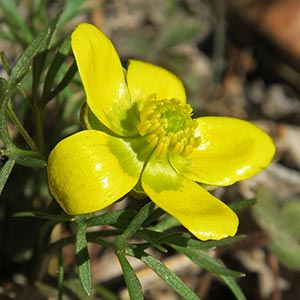Ranunculus repens
Ranunculus triternatus
creeping buttercup
obscure buttercup
Leaves mostly basal; all leaves tri-ternately dissected into linear segments
Flowers 1-several on pedicels up to 10 cm. long;
sepals 5, spreading, purplish-tinged, 5-8 mm. long, glabrous to stiff-hairy;
petals 5, yellow, 8-15 mm. long;
nectary scale wedge-shaped, 1.5-2 mm. long, forming a deep pocket;
receptacle globose;
stamens 40-80;
pistils 30-150.
Achenes 1.5-2 mm. long, obovate, smooth; stylar beak straight, 0.5-0.8 mm. long.
Ranunculus repens
Ranunculus triternatus
Occurring throughout Washington, but more common west of the Cascades crest; Alaska to California and Utah, and from central plains of U.S. to Labrador.
Occurring east of the Cascades crest in Washington, where known from Klickitat County; south-central Washington to Wasco County, Oregon.
- Local floras:
BC,
CA,
OR,
WA
- Local Web sites:
CalFlora,
CalPhotos,
Flora NW,
PNW Herbaria,
Turner Photog.
WildflowerSearch
iNaturalist (observations)
USDA Plants Database
- LBJ Wildflower Center
- SEINet
- Plants of the World Online
- Encyclopedia of Life
- Wikipedia
- Google Image Search



